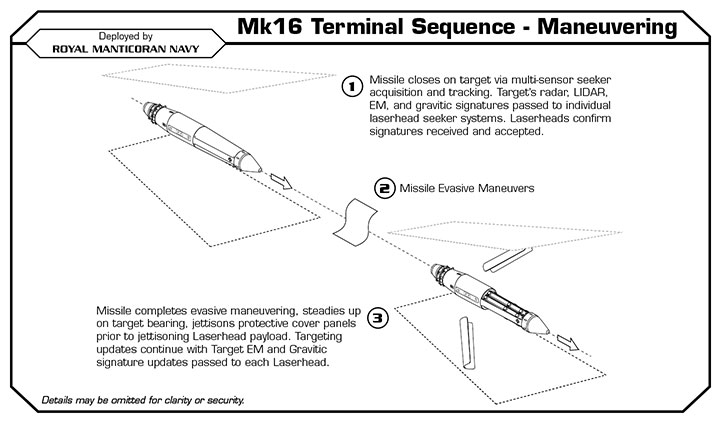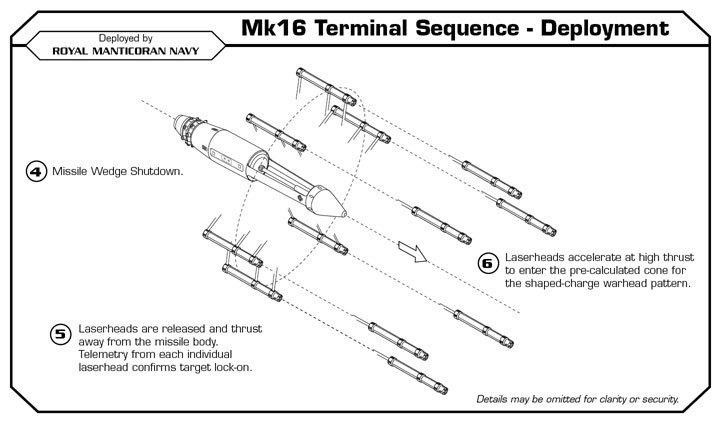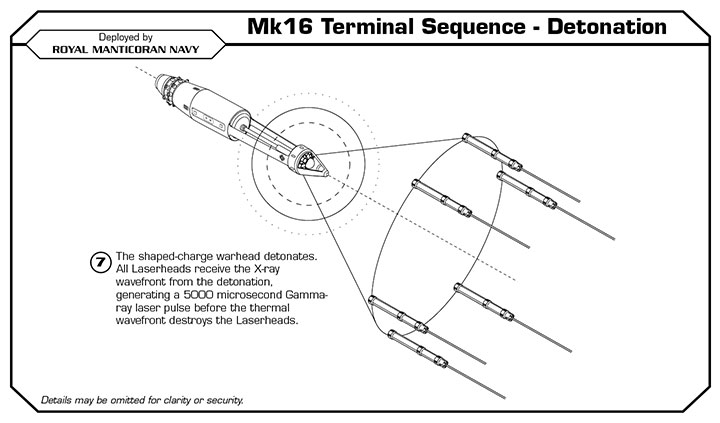penny wrote:The jettisoning system is something that I had to moan over all alone in my ready room. The section containing the warhead has to gain separation from the separated missile body containing the reactor. I considered both a mass driver application and a repulser beam(s). The reason I was enquiring about the mass of the warhead is that if it is insignificant to the application, then a repulser beam may be able to shoot it out like a cannon; IINM that repulser beams are not visible. Admittedly I do not know how bulky mass drivers are, but they are designed to shoot the entire volume of a missile out of tubes very quickly. Handling a small warhead should be easy peasy.
The reactor is still functioning. It can supply power to repulser beams. It can also provide power to some type of ECM. Detonating might provide the ECM if enough separation can be achieved. If not, the reactor can provide power for some type of MAN ECM that is blaring loudly like an old ghetto boom box.
That is less of a reactor ejection system than of a warhead projection system. I can see the value in the later: project it forwards and in the direction of the target, imparting even the necessary rotation it will need to hit the ship. Ejecting the reactor I see no value on: the time between dropping the wedge and the warhead detonating is a couple of milliseconds at most, so the separation it's going to achieve in that is going to be measured in a couple of missile lengths anyway. And that makes detonating the reactor a risky proposition.
The projection system makes sense. And is actually in use: the lasing rods are projected forwards already.
Perhaps you can see me, but your targeting system still has to hit me … in time; after it struggles to find me after my illuminating street light (wedge) duped you and dropped.
That's already the case for all missiles. Dropping the wedge earlier is a worse proposition because it removes the impenetrable barriers for other ships and forces the missile to go ballistically for a longer period. The defending ships' tracking arrays will be looking for the first opportunity to shoot and finding the missile is no more difficult than it was before. This just gives the defending ship more time to shoot.
That won't be the same for other ships that will not be able to find the missile in time after the wedge drops. And if the missile rolls away from the target then deploys some sort of repulser beam to shoot the warhead assembly away quickly, then drops the wedge while the missile orients itself to fire that would solve the problem. The point being that designers of the missile also know the ins-and-outs needed to make it work. And … as I communicated to Thinksmarkedly, when the missile is pitching and yawing, its profile and quickness is important. Do note that radar will lose lock down the throat if the missile momentarily pitches, drops wedge, then reorients and fires. Or whatever field tested results worked.
The warhead can't be shot forwards from the impeller and cross the compensated volume. We don't know how much that is, but the warhead cannot cross it, otherwise the missile body is going to overrun it or the pusher beam is going to shred the warhead. If it crosses that, it's also not going to rotate with the missile when the missile uses the wedge to orient itself on the target.
The rotation is done with the wedge because that is much faster than Newtonian Physics for all we've been told. And therefore, the wedge lip never comes between the missile and its target. There is no moment in which the targeted ship loses track of the missile nose.
Maybe the warhead is shot sideways from the missile, so it quickly falls behind because it continues ballistically while the missile is still accelerating forwards. In that case, the missile becomes a decoy to the actual warhead. The problem then is that the targeted ship sees all of this happen, so it won't work as a surprise after the first salvo. The only question is whether the ship has time to react to it and reorient the PDLC it was veering on the missile to the warhead itself: if the interval is too short, then the PDLC beam can still inflict damage because the separation is too short; if it is long enough, then there's time for the defending ship to react to that warhead that is moving in a predictable fashion and not evading.
At any rate, the missile body containing the reactor is still functioning and should be used in the equation in some capacity if possible.
That being? The missile wedge is not powerful enough to cause damage to the ship if it hits the ship's wedge. And given the velocity it's coming at, it does not have the acceleration to ram the ship: it can only impact the roof or floor of the wedge.
The thing that a reactor can do with its detonation is be effective ECM. That's what a Dazzler does. But a Dazzler does not carry a warhead: so if it were possible to do both, why didn't the RMN do it?













